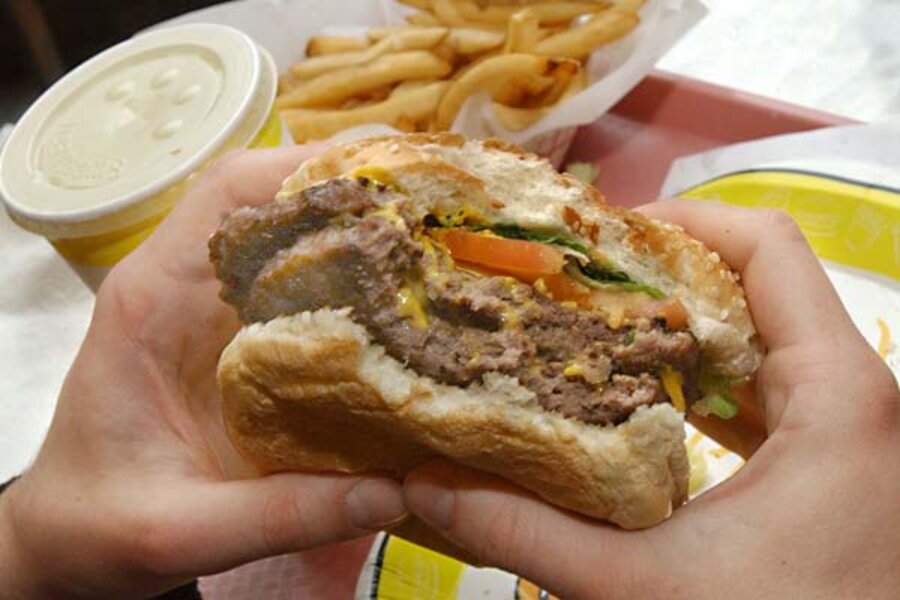The middle class buys more fast food than the poor. Surprised?
Loading...
Jane Black recently wrote a fascinating article for The Atlantic entitled “Fast Food’s Dirty Little Secret: It’s the Middle Class Buying Burgers“:
For years the conventional wisdom has been that fast food is poor people’s food; that, thanks to government subsidies that ensure cheap calories, the drive-through is where people who can’t afford the “good” stuff — organic, grass-fed, etc. — go to feed their families on a budget. Why else would anyone eat that stuff?
But a new study to be published in the Journal for Population Health Management reveals the dirty little secret of the American middle class: It’s not cash-strapped Americans who are devouring the most Big Macs and Whoppers, it’s us! According to the study, a household earning $60,000 a year eats the most fast food, and one bringing in $80,000 is actually more likely to have it their way than one with $30,000. Suddenly, last year’s news from the Centers for Disease Control makes sense: Nearly half of obese adults in this country are not poor but middle-class, earning at least $77,000 for a family of four.
Why?
What actually drives families to the drive-through are two simple truths. First, it’s convenient. Fast-food hours accommodate odd shifts and offer playrooms to appease screaming children and give moms a break. And, after years of calculated expansion, the restaurants are everywhere we are — in office buildings, department stores, rest stops, schools, Walmarts, airports, even hospitals — which makes fast food America’s default dining-out option. Second, people like the way fast food tastes. No matter how often or how loudly food crusaders preach about the nasty and ecologically disastrous bits that end up in those burgers, fast food’s carefully calibrated mix of salt and fat is hard for many to resist.
To put it simply, people don’t roll up to McDonalds and order a double cheeseburger off of the dollar menu because it’s cheap. They do it because it’s convenient and because it is engineered to taste good.
It’s not even cheap, either. As Mark Bittman points out:
In fact it isn’t cheaper to eat highly processed food: a typical order for a family of four — for example, two Big Macs, a cheeseburger, six chicken McNuggets, two medium and two small fries, and two medium and two small sodas — costs, at the McDonald’s a hundred steps from where I write, about $28.
I can make a much better meal than that at home for far less than $28.
So, what’s the point of all of this. The point is that convenience is often the driving factor for people when they make spending choices. They will spend more money and sacrifice other factors such as healthiness in order to maximize convenience.
This is actually a completely understandable thing. If you’re trying to manage a busy career, start a side business, have community responsibilities, and have a spouse and children at home (a situation that sounds awfully familiar to me), convenience can be an enormously important factor. If there’s a way to shave some time out of a daily routine, that usually directly translates into a bit more sleep or a bit more quality time with their family or a bit of simple leisure time.
That’s why I believe that one of the best frugality tactics is to heavily incorporate convenience into your frugal methods. Two examples:
One thing Sarah and I often do is make meals in advance. We’ll either freeze them so that they can easily be pulled out and tossed in the oven, or we’ll package them up in such a way that they can just be tossed into a pot (preferably a crock pot) and cooked with minimal effort. We’ll often assemble a bunch of meals for the next week or two on a weekend afternoon. We’ll do similar things with convenience foods like frozen burritos, too.
I often like to use premeasured soap for washing dishes and laundry. It’s actually really convenient to do this. All you need is a squirt bottle that emits a significant volume per squirt. Then, just figure out how many squirts you need for a load using the actual measurements recommended on the package. So, for example, if it takes two squirts to fill up your laundry detergent cup, then you can just use two quick squirts into the washing machine. This saves money in a very subtle but very real way: we tend to drastically overuse laundry detergent, so a squirter helps out with that problem and causes less detergent to be used per load.
I could go on with many, many examples of this: programmable thermostats, online banking, seasoning packets, and so on.
The key thing to remember is that in the midst of a busy day, convenience will usually trump frugality. If you know that in advance and can make it so that the convenient choice on that busy day is also the frugal choice, you’re going to see some significant savings over time.





